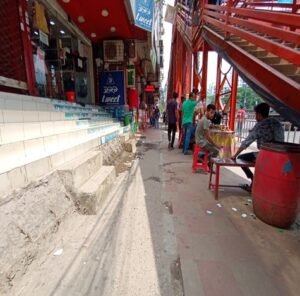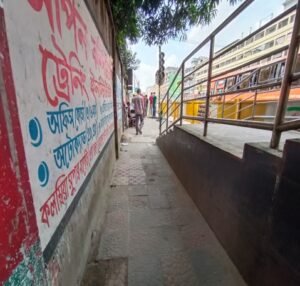Walking is the most sustainable, inclusive, and accessible mode of transportation. Indeed, in a highly densely populated city like Dhaka, walking constitutes a substantial part of daily commuting for a large number of its citizens. However, the infrastructure for walking in Dhaka is, to say the least, woefully inadequate. Since the majority of the population relies on footpaths, especially the low-income group, walkability in Dhaka has drastically declined over the years and demands immediate action.
 Walkability is very important to effective traffic management and is crucial for quality access to pedestrian infrastructure. It eases vehicle congestion, especially during peak hours, by encouraging walking for short trips, while well-designed walkable infrastructure, such as pedestrian crossings and separated walkways, enhances road safety by keeping pedestrians out of vehicular lanes and reducing accidents. Walkability also supports public transport efficiency by providing safe access to transit points, discourages illegal road usage by reducing pedestrian-vehicle conflicts, and fosters sustainable urban mobility with reduced dependence on cars and lower emissions, encouraging a modal shift toward cycling and walking. Moreover, walkable environments ensure discipline in traffic through regulated crossings and footpaths, reduce economic losses due to reduced delays caused by congestion, and enhance urban livability by balancing transport systems. Such cities as Dhaka need to focus on walkability to cope with traffic effectively and build an inclusive, resilient urban future.
Walkability is very important to effective traffic management and is crucial for quality access to pedestrian infrastructure. It eases vehicle congestion, especially during peak hours, by encouraging walking for short trips, while well-designed walkable infrastructure, such as pedestrian crossings and separated walkways, enhances road safety by keeping pedestrians out of vehicular lanes and reducing accidents. Walkability also supports public transport efficiency by providing safe access to transit points, discourages illegal road usage by reducing pedestrian-vehicle conflicts, and fosters sustainable urban mobility with reduced dependence on cars and lower emissions, encouraging a modal shift toward cycling and walking. Moreover, walkable environments ensure discipline in traffic through regulated crossings and footpaths, reduce economic losses due to reduced delays caused by congestion, and enhance urban livability by balancing transport systems. Such cities as Dhaka need to focus on walkability to cope with traffic effectively and build an inclusive, resilient urban future.
Therefore, Nasrin and Affifa (2019) assessed the state of roads in Dhaka. Nasrin and Afifah’s research provides a ray of hope by introducing a comprehensive Walkability Assessment Tool tailored for Dhaka. This tool combines subjective perceptions (surveyors’ observations) with objective measures (quantifiable parameters like footpath width, obstruction, and cleanliness) (Nasrin and Affifa, 2019). The research employs a methodology influenced by the Global Walkability Index (GWI), adapting it to the local context of Dhaka. This approach allows for a qualitative analysis of walking conditions, focusing on safety, security, and convenience for pedestrians. While the study is centered on Dhaka, the methodology and findings can be applicable to other developing cities with similar characteristics. This broadens the scope of the research, making it relevant for urban planners and policymakers in various contexts.
Practical Implications of the Walkability Assessment Tool and Traffic Management

Overall, the practical implications of walkability assessment tool developed by Nasrin and Afifah (2019) extend beyond Dhaka, offering valuable insights for urban planners, policymakers, and researchers in developing countries facing similar challenges.
- Improving Pedestrian Safety: The assessment of walkability directly impacts traffic management by identifying areas where pedestrian safety is compromised. The study highlighted issues such as inadequate pedestrian lighting and the presence of obstructions on footpaths, which can lead to accidents. By addressing these safety concerns, traffic management can create safer environments for pedestrians, reducing the likelihood of road casualties.
- Influencing Traffic Flow: Understanding pedestrian behavior and their interactions with vehicular traffic can help traffic management optimize traffic flow. The paper discusses how aggressive driving behavior negatively affects road safety, indicating that better management of motorist behavior could enhance pedestrian safety and comfort.
- Integration of Pedestrian Facilities: The findings from the walkability assessment can inform traffic management strategies by integrating pedestrian facilities into urban planning. For instance, the study emphasized the need for proper pedestrian amenities and crossings, which can be incorporated into traffic management plans to ensure that pedestrian needs are met alongside vehicular traffic.
- Data-Driven Decision Making: The methodology used in the study, which combines subjective and objective assessments, provided valuable data that can be utilized in traffic management. This data can help identify critical areas that require intervention, such as the installation of traffic safety devices or improvements in pedestrian infrastructure.
- Promoting Sustainable Transport: By highlighting the importance of walking as a sustainable mode of transport, the paper aligned with traffic management goals aimed at reducing congestion and promoting environmentally friendly transportation options. Encouraging walking can alleviate traffic pressure, especially in densely populated urban areas like Dhaka.
- Policy Development: The insights gained from the walkability assessment can aid policymakers in developing effective traffic management policies that prioritize pedestrian safety and accessibility. This can lead to a more balanced approach to urban mobility, where the needs of both pedestrians and vehicles are considered.
In summary, the walkability assessment tool developed in this paper has significant implications for traffic management by enhancing pedestrian safety, influencing traffic flow, integrating pedestrian facilities, providing data for decision-making, promoting sustainable transport, and aiding policy development.
To improve traffic management and walkability in Dhaka, the following measures are suggested:
- Enforce strict regulations to curb illegal encroachments and reckless driving.
- Prioritize pedestrian infrastructure in urban planning with adequate funding for construction and maintenance.
- Introduce technology-driven solutions like real-time traffic monitoring and mobile reporting tools.
- Conduct awareness campaigns to promote shared responsibility among drivers and pedestrians.
By addressing these issues, Dhaka can achieve safer, more efficient traffic management while fostering a walkable, inclusive urban environment.
Reference:
Nasrin and F. Afifah 2019 IOP Conf. Ser.: Mater. Sci. Eng. 527 012073 DOI 10.1088/1757-899X/527/1/012073
To read this paper:
https://iopscience.iop.org/article/10.1088/1757-899X/527/1/012073



Leave A Comment